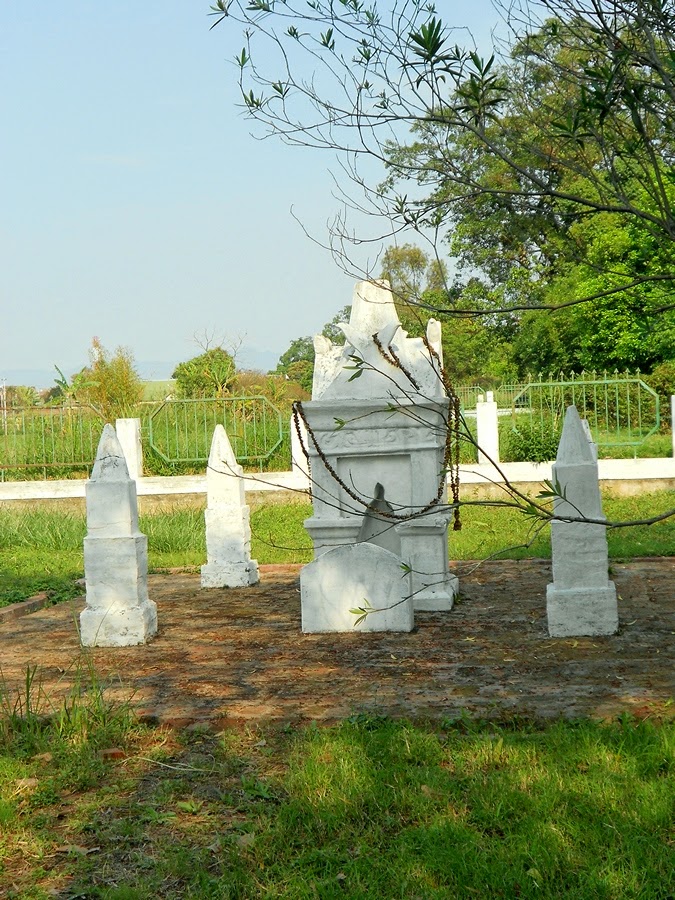For those who are not aware, one of Manipur's contribution to the world is the game of polo. Sadly, no game was scheduled when I visited. So I gazed at an empty ground. This is the main ground in the centre of Imphal. The large hoarding proclaimed: "WE GAVE THE WORLD THE GAME OF POLO."
Kangla Fort in Imphal has a considerable amount of Manipuri history within its walls. For Manipur, the Kangla Fort represents the beginning of their history, going back over 2000 years. The entry fee is a humble Rs 5. As much as a small packet of roasted peanuts from a roadside cart.
The British captured Kangla in 1891 after stiff resistance from the Manipuri army. After India's independence in 1947, the Assam Rifles occupied Kangla until as late as 2004. Two moats guard the fortress city of Kangla, an outer and inner moat.
Two huge figures guard the entrance to the coronation hall of Kings, called Uttra. The area was damaged during the air raids of World War II.
The Ibudhou Pakhangba temple at Kangla Fort is a popular spot for worship. The grounds are large. Ancestor worship is commonly practised around the grounds of the temple.
An enclosure nearby protects the snake like figures that are sacred to the Meitei people. Originally open, the figures have been protected due to vandalism. The photo below was taken from outside the glass walls.
Legend has it that a powerful army general is buried at this spot.
Ruins of the past era are found at the enclosure leading to the Govindajee Temple of the Old Palace.
The Kings of Manipur actively encouraged cultural performances in the courtyard of the Govindajee temple. The temple was partially destroyed in an earthquake in 1868.
Kangla Fort houses the Samadhi of Maharaj Bodhachandra, a fearless king who stood up against foreign domination.
Field Marshal Slim from Britain was in charge of the Allied forces during WWII. He directed operations against the revolutionary Indian National Army (INA) supported by the Japanese. His home was within the Kangla Fort.
The photo below was taken at the private INA Museum in Imphal.
Kangla Fort is an extremely peaceful place to wander around. The slanting
rays of the late afternoon sun with their play of light and shadow add an element of mystery to the environment.
The internal moat presents a serene picture late in the afternoon, draped by warm sunlight.
Polo is synonymous with Manipur. There are several Polo grounds within the Kangla Fort complex.
Manipur, given its relatively small area and population, excels at several sports. The Sports Authority of India (SAI) has a sprawling campus in Imphal. The state Taekwondo competition was going on, which I had an opportunity to witness for a while.
The Shaheed Minar is a tall monument in Imphal that represents the indomitable spirit of patriotism of the Manipuris who laid down their lives in the last Anglo-Manipuri War of 1891. Martyrs were hanged to death at this spot in 1891. The Shaheed Minar seems to symbolize the loss of independence of the Kingdom of Manipur. The British took over Kangla Fort at that time.
The Nupi Lal Memorial Complex nearby is a tribute to the courageous Manipuri women who sacrifice thier lives fighting for justice against the British in December 1939. The gate of this memorial was locked.
I tried a closer look through the zoom lens of my little point and shoot camera. That's the best I could do. This memorial seems to be little publicized and little visited. The Tourism Department probably does not deem it worthy of being kept open as a monument. Yet another instance of North Eastern patriotism going unrecognized and unsung?
Manipur is famed for its classical dance and music. I got a chance to spend a few pleasant moments at a song and dance performance. The dancers are graceful, accompanied by music that is soft and melodious.
Until my visit, I had not been aware of the number of patriotic incidents in Imphal. I was left wondering, unlike me, how many Indians have heard of the brave ladies who fought against British occupation? Further, I wondered how many Indians have heard about the existence of the Shaheed Minar in Imphal?
Along with the brave exploits of the Indian National Army (INA) leading up to the Battles of Imphal and Kohima that attempted to win India's independence in 1944, these two patriotic acts of 1891 and 1939 have also been virtually consigned to the bins of history.
It's never too late to learn history, is it? Well, do you think there is a likelihood of these heroic incidents ever appearing in our History text books?
<Add a wry smiley here>.
-=-=-=-=-=-=-=-=-=
The posts in this series are listed below.























No comments:
Post a Comment
Your comments...